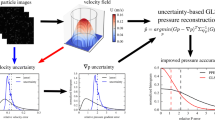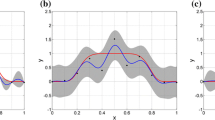Abstract
Velocity field measurements allow, in principle, the evaluation of the pressure field by integrating the equations of fluid motion. Unavoidable experimental uncertainty, however, may result in unreliable estimates. In this study, we use the Poisson pressure equation to estimate the relative pressure from experimental velocities, and investigate how pre-processing with smoothing and solenoidal filters affects this estimate. For diffusion dominated laminar flow or for turbulent flow modeled through an eddy viscosity, measurement noise significantly affects the results. In this case, solenoidal filtering provides superior performance over other smoothing approaches, as it preserves the second spatial derivatives of the velocity field. For laminar flows dominated by advection or acceleration components of the pressure gradient, the choice of the filter appears to have little effect under limited noise, while smoothing produces improved relative pressure estimates for higher noise intensities. The above statements are verified using idealized flow conditions, numerical fluid dynamics simulations, and velocity fields from in-vivo and in-vitro magnetic resonance velocimetry.

















Similar content being viewed by others
References
Adrian RJ (2005) Twenty years of particle image velocimetry. Exp Fluids 39(2):159–169
Andersen AH, Kirsch JE (1996) Analysis of noise in phase contrast MR imaging. Med Phys 23(6):857–869
Azijli I, Dwight RP (2015) Solenoidal filtering of volumetric velocity measurements using Gaussian process regression. Exp Fluids 56(11):1–18
Banko AJ, Coletti F, Schiavazzi D, Elkins CJ, Eaton JK (2015) Three-dimensional inspiratory flow in the upper and central human airways. Exp Fluids 56(6):1–12
Bermejo J, Martínez-Legazpi P, del Álamo JC (2015) The clinical assessment of intraventricular flows. Annu Rev Fluid Mech 47:315–342
Blinde P, Michaelis D, Van Oudheusden B, Weiss PE, de Kat R, Laskari A, Jeon JY, David L, Schanz D, Huhn F, Gesemann S, Novara M, McPhaden C, Neeteson N, Rival D, Schneiders JFG, Schrijer F (2016) Comparative assessment of PIV-based pressure evaluation techniques applied to a transonic base flow. In: 18th international symposium on applications of laser techniques to fluid mechanics
Briant JK, Cohen BS (1989) Flow distribution through human and canine airways during inhalation and exhalation. J Appl Physiol 67(4):1649–1654
Charonko JJ, King CV, Smith BL, Vlachos PP (2010) Assessment of pressure field calculations from particle image velocimetry measurements. Meas Sci Technol 21(10):105401
Cohen BS, Sussman RG, Lippmann M (1993) Factors affecting distribution of airflow in a human tracheobronchial cast. Respir Physiol 93(3):261–278
Coletti F, Muramatsu K, Schiavazzi D, Elkins CJ, Eaton JK (2014) Fluid flow and scalar transport through porous fins. Phys Fluids 26(5):055104
Comer JK, Kleinstreuer C, Zhang Z (2001) Flow structures and particle deposition patterns in double-bifurcation airway models. Part 1. Air flow fields. J Fluid Mech 435:25–54
Dabiri JO, Bose S, Gemmell BJ, Colin SP, Costello JH (2013) An algorithm to estimate unsteady and quasi-steady pressure fields from velocity field measurements. J Exp Biol 217:331–336
Deardorff JW (1970) A numerical study of three-dimensional turbulent channel flow at large Reynolds numbers. J Fluid Mech 41(02):453–480
Donati F, Figueroa CA, Smith NP, Lamata P, Nordsletten DA (2015) Non-invasive pressure difference estimation from PC-MRI using the work-energy equation. Med Image Anal 26(1):159–172
Ebbers T, Farnebäck G (2009) Improving computation of cardiovascular relative pressure fields from velocity MRI. J Magn Reson Imaging 30(1):54–61
Ebbers T, Wigström L, Bolger AF, Engvall J, Karlsson M (2001) Estimation of relative cardiovascular pressures using time-resolved three-dimensional phase contrast MRI. Magn Reson Med 45(5):872–879
Elkins CJ, Alley MT (2007) Magnetic resonance velocimetry: applications of magnetic resonance imaging in the measurement of fluid motion. Exp Fluids 43(6):823–858
Foucaut JM, Stanislas M (1058) Some considerations on the accuracy and frequency response of some derivative filters applied to particle image velocimetry vector fields. Meas Sci Technol 13(7):2002
Freudenhammer D, Baum E, Peterson B, Böhm B, Jung B, Grundmann S (2014) Volumetric intake flow measurements of an IC engine using magnetic resonance velocimetry. Exp Fluids 55(5):1–18
Gresho PM, Sani RL (1987) On pressure boundary conditions for the incompressible Navier-Stokes equations. Int J Numer Methods Fluids 7(10):1111–1145
Grundmann S, Wassermann F, Lorenz R, Jung B, Tropea C (2012) Experimental investigation of helical structures in swirling flows. Int J Heat Fluid Flow 37:51–63
Gudbjartsson H, Patz S (1995) The Rician distribution of noisy MRI data. Magn Reson Med 34(6):910–914
Ham F, Iaccarino G (2004) Energy conservation in collocated discretization schemes on unstructured meshes. Annu Res Briefs 3–14:2004
Ham F, Mattsson K, Iaccarino G (2006) Accurate and stable finite volume operators for unstructured flow solvers. In: Annual Research Briefs, Center for Turbulence Research, Stanford University, pp 243–261
Hearst RJ, Buxton ORH, Ganapathisubramani B, Lavoie P (2012) Experimental estimation of fluctuating velocity and scalar gradients in turbulence. Exp fluids 53(4):925–942
Heroux M, Bartlett R, Howle V, Hoekstra R, Hu J, Kolda T, Lehoucq R, Long K, Pawlowski R, Phipps E, Salinger A, Thornquist H, Tuminaro R, Willenbring J, Williams A (2003) An overview of trilinos. Technical Report SAND2003-2927, Sandia National Laboratories
Jalal S, Nemes A, Van de Moortele T, Schmitter S, Coletti F (2016) Three-dimensional inspiratory flow in a double bifurcation airway model. Exp Fluids 57(9):148
Kassinos S, Langer C, Iaccarino G, Moin P (2007) Complex effects in large eddy simulations. Springer Science and Business Media, Berlin
Krittian SBS, Lamata P, Michler C, Nordsletten DA, Bock J, Bradley CP, Pitcher A, Kilner PJ, Markl M, Smith NP (2012) A finite-element approach to the direct computation of relative cardiovascular pressure from time-resolved MR velocity data. Med Image Anal 16(5):1029–1037
Lamata P, Pitcher A, Krittian S, Nordsletten D, Bissell MM, Cassar T, Barker AJ, Markl M, Neubauer S, Smith NP (2014) Aortic relative pressure components derived from four-dimensional flow cardiovascular magnetic resonance. Magn Reson Med 72(4):1162–1169
Laskari A, de Kat R, Ganapathisubramani B (2016) Full-field pressure from snapshot and time-resolved volumetric PIV. Exp Fluids 57(3):1–14
Lilly DK (1967) The representation of small scale turbulence in numerical simulation experiments. In: IBM scientific computing symposium on environmental sciences, IBM, Data processing Division, pp 195–210
Liu X, Katz J (2006) Instantaneous pressure and material acceleration measurements using a four-exposure PIV system. Exp Fluids 41(2):227–240
Longest PW, Vinchurkar S (2007) Effects of mesh style and grid convergence on particle deposition in bifurcating airway models with comparisons to experimental data. Med Eng Phys 29(3):350–366
Markl M, Chan FP, Alley MT, Wedding KL, Draney MT, Elkins CJ, Parker DW, Wicker R, Taylor CA, Herfkens RJ et al (2003) Time-resolved three-dimensional phase-contrast MRI. J Magn Reson Imaging 17(4):499–506
Markl M, Kilner PJ, Ebbers T (2011) Comprehensive 4D velocity mapping of the heart and great vessels by cardiovascular magnetic resonance. J Cardiovasc Magn Reson 13(7):10–1186
Pelc NJ, Herfkens RJ, Shimakawa A, Enzmann DR (1991) Phase contrast cine magnetic resonance imaging. Magn Reson Q 7(4):229–254
Pelc NJ, Sommer FG, Li KC, Brosnan TJ, Herfkens RJ, Enzmann DR (1994) Quantitative magnetic resonance flow imaging. Magn Reson Q 10(3):125–147
Pozrikidis C (2001) A note on the regularization of the discrete Poisson-Neumann problem. J Comput Phys 172(2):917–923
Schiavazzi D, Coletti F, Iaccarino G, Eaton JK (2014) A matching pursuit approach to solenoidal filtering of three-dimensional velocity measurements. J Comput Phys 263:206–221
Schneiders JFG, Pröbsting S, Dwight RP, van Oudheusden BW, Scarano F (2016) Pressure estimation from single-snapshot tomographic PIV in a turbulent boundary layer. Exp Fluids 57(4):1–14
Schroeder WJ, Lorensen B, Martin K (2004) The visualization toolkit. Kitware, New York
Sherman TF (1981) On connecting large vessels to small. The meaning of Murray’s law. J Gen Physiol 78(4):431–453
Smagorinsky J (1963) General circulation experiments with the primitive equations: I. The basic experiment. Mon Weather Rev 91(3):99–164
Song SM, Leahy RM, Boyd DP, Brundage BH, Napel S (1994) Determining cardiac velocity fields and intraventricular pressure distribution from a sequence of ultrafast CT cardiac images. Med Imaging IEEE Trans 13(2):386–397
Vahanian A, Baumgartner H, Bax J, Butchart E, Dion R, Filippatos G, Flachskampf F, Hall R, Iung B, Kasprzak J et al (2007) Guidelines on the management of valvular heart disease. Eur Heart J 28(2):230–268
Van Oudheusden BW (2013) PIV-based pressure measurement. Meas Sci Technol 24(3):032001
Weibel ER (1963) Geometry and dimensions of airways of conductive and transitory zones. Springer, New York
Whiting CH, Jansen KE (2001) A stabilized finite element method for the incompressible Navier-Stokes equations using a hierarchical basis. Int J Numer Methods Fluids 35(1):93–116
Wilcox DC (1998) Turbulence modeling for CFD. DCW industries, La Canada Flintridge
Wilson N, Wang K, Dutton RW, Taylor C (2001) A software framework for creating patient specific geometric models from medical imaging data for simulation based medical planning of vascular surgery. In: Medical image computing and computer-assisted intervention-MICCAI 2001, Springer, pp 449–456
Worth P, Longest, Vinchurkar S (2007) Validating CFD predictions of respiratory aerosol deposition: effects of upstream transition and turbulence. J Biomech 40(2):305–316
Yang GZ, Kilner PJ, Wood NB, Underwood SR, Firmin DN (1996) Computation of flow pressure fields from magnetic resonance velocity mapping. Magn Reson Med 36(4):520–526
Acknowledgements
The authors would like to thank the two anonymous reviewers for their comments and feedback that greatly contributed to improve the consistency and quality of the present contribution. This work was supported by the American Heart Association Grant #15POST23010012 (Daniele Schiavazzi), the Leducq Foundation as part of a Transatlantic Network of Excellence for Cardiovascular Research, and a National Science Foundation (Chemical, Bioengineering, Environmental, and Transport Systems) CAREER Grant #1453538 (Filippo Coletti). The authors would like to thank Gianluca Iaccarino, Javier Urzay Lobo, Gianluca Geraci, and Dante De Santis for the interesting and motivating discussions, and Jorge Bernate for providing the large eddy simulation results on the human airways model. We also acknowledge the open source SimVascular project at http://www.simvascular.org.
Author information
Authors and Affiliations
Corresponding author
Rights and permissions
About this article
Cite this article
Schiavazzi, D.E., Nemes, A., Schmitter, S. et al. The effect of velocity filtering in pressure estimation. Exp Fluids 58, 50 (2017). https://doi.org/10.1007/s00348-017-2314-1
Received:
Revised:
Accepted:
Published:
DOI: https://doi.org/10.1007/s00348-017-2314-1




